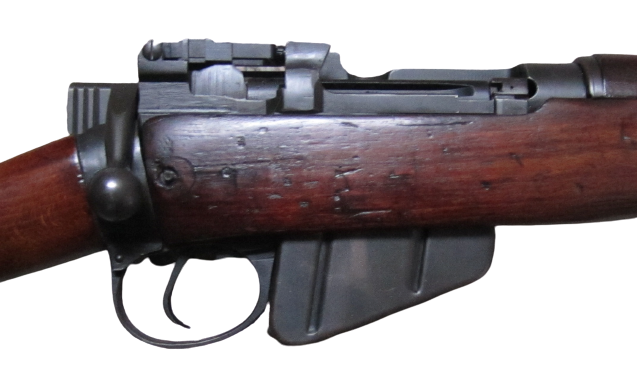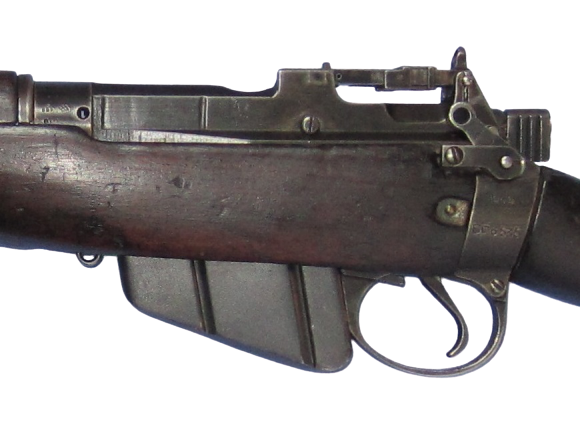Work began on a lightened rifle as early as 1942 but it was the jungle fighting in the Far East that made the requirement more urgent since it was found that the No. 4 rifle was not ideal because of its length and weight. The first lightened models were produced in 1943 and were essentially shortened No. 4 rifles. Although accuracy was comparable with a No. 4 rifle up to 500 yds, it was found that recoil and muzzle flash were excessive. Small numbers of lightened rifle were issued for troop trials and various forms of flash hider were tried during this period.
As the requirement was urgent, the normal development stages for a new model of rifle were minimised and by December 1943 production had started at the Royal Small Arms Factory (RSAF) Fazakerley for 1000 shortened rifles. The early models were not fitted with a fore-end metal cap but one was requested in May 1944 to seal the end grain. At least two variations of the end cap were tried but, later on, it was dropped in favour of a rounded fore-end. The final design of the Lee-Enfield No. 5 rifle was officially approved in September 1944. Although not an official title, the No. 5 rifle is often referred to as the Jungle Carbine.

Design Features
The No. 5 Mk I rifle was essentially a No. 4 rifle with the barrel length reduced from 25.2 inch to 18.7 inch. However, it was then found that a flash hider was needed. This was pinned on the end of the barrel and incorporated the front sight and protection wings as well as a lug for the No. 5 bayonet. The No. 5 bayonet consisted of an 8 inch Bowie style blade with fuller grooves on both sides which was fixed to the rifle via a lug and supported by the flash hider via a ring on the quillon.

When compared with a standard No. 4 rifle, the receiver body of the No. 5 rifle was lightened by having metal milled off both sides just behind the charger bridge as shown below. The barrel knox was also lightened via four scoops milled into it and the end of the bolt handle was also drilled out. Given the later problems with the accuracy of the rifle and the fact that the metal removed would not have produced much of a reduction in the weight of the rifle, it is difficult to see why this machining would have been considered worth doing.


No. 5 rifle on the left showing removed metal behind charger bridge compared with No. 4 rifle on the right


The No. 5 rifle was fitted with the same Mk I ladder sight as the No. 4 rifle except that it marked from 200 to 800 yds. The front sight is a blade. The No. 5 rifle used a cut down version of the hand guard used on the No. 4 rifle. At the front this was retained via a barrel band athat incorporated the upper sling swivel. The butt stock on the No. 5 rifle was not as wide at the rear as on the No. 4 rifle and incorporated a sheet metal butt plate that included a rubber recoil pad. The lower sling attachment on the side of the butt consisted of a bar fixed to the butt plate.

Just over 81,000 No. 5 rifles were produced at BSA Shirley with RSAF Fazakerley producing at least 170,000. The No. 4 rifle was never manufactured in India or Australia and, as a consequence, they therefore did not produce the No. 5 rifle. Canada did experiment with a lightened No. 4 rifle but this did not go into production. Eventually, many of the British manufactured No. 5 rifles went to India and Pakistan where they were re-furbished before being issued.
Wandering Zero Issue
The No. 5 rifle was well liked by soldiers because of its weight and ease of handling but there were complaints about its accuracy and its ability to maintain its zero and shoot consistently. This was investigated at various times and some evidence found that the flash hider and the metal removed to lighten the receiver were the cause of the zeroing difficulties. Although these problems could almost certainly have been overcome, there was undoubtedly a strong motivation on the part of the military to adopt a self-loading rifle in the late 1940’s rather than a carbine version of a 60 year bolt action rifle. Whatever the motivation, the No. 5 rifle was declared obsolete in July 1947.
My No. 5 Mk I Rifle
My No. 5 rifle was manufactured in 1945 by BSA Shirley. Although the receiver, stock and bolt bear the same serial number, the latter does not have a drilled bolt handle. The stock had a transverse wood screw through the stock when I acquired the rifle (which I removed) indicating that it must have been refurbished in India before eventually finding its way back to the UK.
My No. 5 rifle was deactivated to the Old Spec meaning that it will dry fire. Prior to buying the rifle, I had already acquired a No. 5 bayonet. I have experience of firing a No. 4 rifle and was used to it size and weight. However, my No. 5 rifle does give an understanding of why the troops liked it because it is not only a purposeful looking weapon but also handles very well. Despite the history of zeroing problems, the experience of more recent firers of this weapon do not appear to report any accuracy problems, certainly up to 300 yds.

Rifle No. 5 Mk I Specifications
- Weight: 7 lb 1 oz empty
- Weight of Full magazine: 13 oz
- Weight of Bayonet: 7 oz
- Length of Rifle: 3 ft 3.5 in
- Length with Bayonet: 4 ft 0.1 in
- Length of Barrel: 20.5/18.7 in with/without flash hider
- Calibre: .303 in
- Rifling: Enfield Segmental
- Bullet: 174 gr jacketed round nosed lead
- Muzzle Velocity: 2250 fps (.303 Mk VII)
- Front Sight: Blade
- Rear Sight: Aperture
- Rear Sight Leaf: 200 to 800 yds
- No. of Grooves: 5
- Depths of Grooves: .005 in
- Width of Grooves: .0936 in
- Rifling Twist: Left-handed with 1 turn in 10 in
![]()

